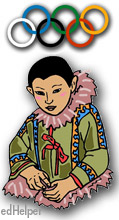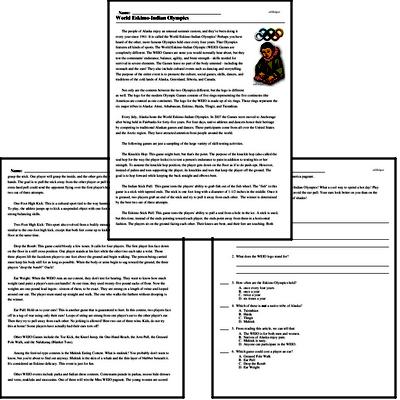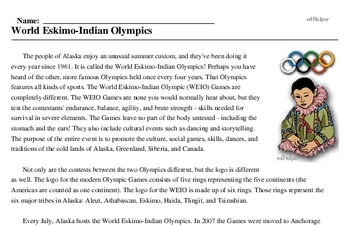World Eskimo-Indian Olympics
World Eskimo-Indian Olympics Week
Reading Comprehension for July 21
The people of Alaska enjoy an unusual summer custom, and they've been doing it every year since 1961. It is called the World Eskimo-Indian Olympics! Perhaps you have heard of the other, more famous Olympics held once every four years. That Olympics features all kinds of sports. The World Eskimo-Indian Olympic (WEIO) Games are completely different. The WEIO Games are none you would normally hear about, but they test the contestants' endurance, balance, agility, and brute strength - skills needed for survival in severe elements. The Games leave no part of the body untested - including the stomach and the ears! They also include cultural events such as dancing and storytelling. The purpose of the entire event is to promote the culture, social games, skills, dances, and traditions of the cold lands of Alaska, Greenland, Siberia, and Canada.
Not only are the contests between the two Olympics different, but the logo is different as well. The logo for the modern Olympic Games consists of five rings representing the five continents (the Americas are counted as one continent). The logo for the WEIO is made up of six rings. Those rings represent the six major tribes in Alaska: Aleut, Athabascan, Eskimo, Haida, Tlingit, and Tsimshian.
Every July, Alaska hosts the World Eskimo-Indian Olympics. In 2007 the Games were moved to Anchorage after being held in Fairbanks for forty-five years. For four days, native athletes and dancers honor their heritage by competing in traditional Alaskan games and dances. These participants come from all over the United States and the Arctic region. They have attracted attention from people around the world.
The following games are just a sampling of the large variety of skill-testing activities.
The Knuckle Hop: This game might hurt, but that's the point. The purpose of the knuckle hop (also called the seal hop for the way the player looks) is to test a person's endurance to pain in addition to testing his or her strength. To assume the knuckle hop position, the player gets down on the floor as if to do push-ups. However, instead of palms and toes supporting the player, its knuckles and toes that keep the player off the ground. The goal is to hop forward while keeping the back straight and elbows bent.
The Indian Stick Pull: This game tests the players' ability to grab fish out of the fish wheel. The "fish" in this game is a stick with tapered ends. The stick is one foot long with a diameter of 1-1/2 inches in the middle. Once it is greased, two players grab an end of the stick and try to pull it away from each other. The winner is determined by the best two out of three attempts.
The Eskimo Stick Pull: This game tests the players' ability to pull a seal from a hole in the ice. A stick is used, but this time, instead of the ends pointing toward each player, the ends point away from them in a horizontal fashion. The players sit on the ground facing each other. Their knees are bent, and their feet are touching. Both grasp the stick. One player will grasp the inside, and the other gets the outside. They leave no gaps between their hands. The goal is to pull the stick away from the other player or pull the player over to the other side. An extra-hard pull could send the opponent flying over the first player's head! The winner is determined by the best two out of three attempts.
One-Foot High Kick: This is a cultural sport tied to the way hunters used to send messages to nearby villages. To play, the athlete jumps up to kick a suspended object with one foot and then lands on that one foot, displaying strong balancing skills.
Two-Foot High Kick: This sport also evolved from a bodily message sent by hunters to nearby villages. It is similar to the one-foot high kick, except that both feet come up to kick the suspended object and return to the floor at the same time.




